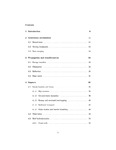Infragravity waves: From driving mechanisms to impacts
| dc.contributor.author | Bertin, X | |
| dc.contributor.author | Mikhalenko, Natalia | |
| dc.date.accessioned | 2018-02-21T11:24:20Z | |
| dc.date.available | 2018-02-21T11:24:20Z | |
| dc.date.issued | 2018-02 | |
| dc.identifier.issn | 0012-8252 | |
| dc.identifier.issn | 1872-6828 | |
| dc.identifier.uri | http://hdl.handle.net/10026.1/10836 | |
| dc.description.abstract |
Infragravity (hereafter IG) waves are surface ocean waves with frequencies below those of wind-generated “short waves” (typically below 0.04 Hz). Here we focus on the most common type of IG waves, those induced by the presence of groups in incident short waves. Three related mechanisms explain their generation: (1) the development, shoaling and release of waves bound to the short-wave group envelopes (2) the modulation by these envelopes of the location where short waves break, and (3) the merging of bores (breaking wave front, resembling to a hydraulic jump) inside the surfzone. When reaching shallow water (O(1–10 m)), IG waves can transfer part of their energy back to higher frequencies, a process which is highly dependent on beach slope. On gently sloping beaches, IG waves can dissipate a substantial amount of energy through depth-limited breaking. When the bottom is very rough, such as in coral reef environments, a substantial amount of energy can be dissipated through bottom friction. IG wave energy that is not dissipated is reflected seaward, predominantly for the lowest IG frequencies and on steep bottom slopes. This reflection of the lowest IG frequencies can result in the development of standing (also known as stationary) waves. Reflected IG waves can be refractively trapped so that quasi-periodic along-shore patterns, also referred to as edge waves, can develop. IG waves have a large range of implications in the hydro-sedimentary dynamics of coastal zones. For example, they can modulate current velocities in rip channels and strongly influence cross-shore and longshore mixing. On sandy beaches, IG waves can strongly impact the water table and associated groundwater flows. On gently sloping beaches and especially under storm conditions, IG waves can dominate cross-shore sediment transport, generally promoting offshore transport inside the surfzone. Under storm conditions, IG waves can also induce overwash and eventually promote dune erosion and barrier breaching. In tidal inlets, IG waves can propagate into the back-barrier lagoon during the flood phase and induce large modulations of currents and sediment transport. Their effect appears to be smaller during the ebb phase, due to blocking by countercurrents, particularly in shallow systems. On coral and rocky reefs, IG waves can dominate over short-waves and control the hydro-sedimentary dynamics over the reef flat and in the lagoon. In harbors and semi-enclosed basins, free IG waves can be amplified by resonance and induce large seiches (resonant oscillations). Lastly, free IG waves that are generated in the nearshore can cross oceans and they can also explain the development of the Earth's “hum” (background free oscillations of the solid earth). | |
| dc.format.extent | 774-799 | |
| dc.language | en | |
| dc.language.iso | en | |
| dc.publisher | Elsevier | |
| dc.subject | Infragravity waves | |
| dc.subject | Bound wave | |
| dc.subject | Dissipation | |
| dc.subject | Reflection | |
| dc.subject | Sediment transport | |
| dc.subject | Barrier breaching | |
| dc.subject | Seiche | |
| dc.subject | Earth hum | |
| dc.title | Infragravity waves: From driving mechanisms to impacts | |
| dc.type | journal-article | |
| dc.type | Review | |
| dc.type | Journal | |
| plymouth.author-url | https://www.webofscience.com/api/gateway?GWVersion=2&SrcApp=PARTNER_APP&SrcAuth=LinksAMR&KeyUT=WOS:000426409200041&DestLinkType=FullRecord&DestApp=ALL_WOS&UsrCustomerID=11bb513d99f797142bcfeffcc58ea008 | |
| plymouth.volume | 177 | |
| plymouth.publication-status | Published | |
| plymouth.journal | Earth-Science Reviews | |
| dc.identifier.doi | 10.1016/j.earscirev.2018.01.002 | |
| plymouth.organisational-group | /Plymouth | |
| plymouth.organisational-group | /Plymouth/Faculty of Science and Engineering | |
| plymouth.organisational-group | /Plymouth/Faculty of Science and Engineering/School of Biological and Marine Sciences | |
| plymouth.organisational-group | /Plymouth/REF 2021 Researchers by UoA | |
| plymouth.organisational-group | /Plymouth/REF 2021 Researchers by UoA/UoA07 Earth Systems and Environmental Sciences | |
| plymouth.organisational-group | /Plymouth/Research Groups | |
| plymouth.organisational-group | /Plymouth/Research Groups/Marine Institute | |
| plymouth.organisational-group | /Plymouth/Users by role | |
| plymouth.organisational-group | /Plymouth/Users by role/Academics | |
| dcterms.dateAccepted | 2018-01-03 | |
| dc.rights.embargodate | 2019-1-9 | |
| dc.identifier.eissn | 1872-6828 | |
| dc.rights.embargoperiod | Not known | |
| rioxxterms.versionofrecord | 10.1016/j.earscirev.2018.01.002 | |
| rioxxterms.licenseref.uri | http://www.rioxx.net/licenses/all-rights-reserved | |
| rioxxterms.licenseref.startdate | 2018-02 | |
| rioxxterms.type | Journal Article/Review |


